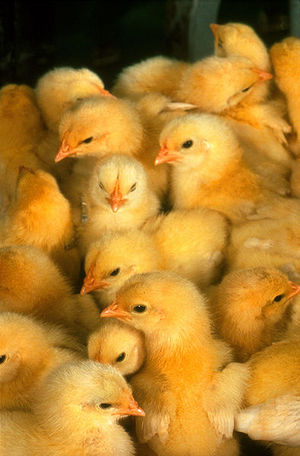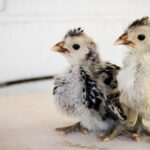Of all the baby animals I’ve raised, chicks are probably the easiest. They don’t require 2am walks or complicated diets. On a small scale or large, they have just a few basic needs, and once those needs are met they most often stay happy, healthy, and grow like weeds.
Briefly, chicks need food, water, warmth, companionship and cleanliness. First, the simplest, companionship — chicks should never be raised alone. Lone chicks spend all their waking hours crying for company, and may just wilt away and die. The solution is easy: two or more chicks will keep each other company, and they can be raised in very large groups if space is available.
Day old chicks don’t need much room — a few square feet will do for 10 chicks — but need progressively more as they get older and bigger. Many people use cardboard “fences” (available from most feed stores and poultry supply sources) surrounding newspaper-covered floor in their garage, shed or coop. These fences offer the advantage of being easily adjustable in size, and can be expanded as the chicks grow. However, if you don’t have a space outside the house to raise chicks, or you’re raising them in winter when it’s too cold, this may just be too messy for in-home use. I’ve made indoor chick housing out of large plastic storage bins, cardboard boxes lined with a tarp on the bottom, and maybe my favorite in-home chick brooder — the collapsible baby crib/playpen. These have plastic bottoms for easy cleaning, and fold away for storage. They’re probably too expensive if you’re just raising chicks once, and too small for large numbers of chicks, but if, like me, you find yourself raising small numbers of chicks once a year or so, they’re perfect. The important thing about any chick housing is that it’s escape-proof, draft-proof, easy to heat, and easy to clean. I’ve even heard of chicks being raised in spare bathtubs!
Heating will be the next step. Most popular are infrared heating bulbs, installed in hanging or clamping fixtures that can be raised or lowered depending on the chicks’ needs. An alternative to infrared bulbs are ceramic heat bulbs made for reptiles. These are more expensive but last much longer, and don’t put off any light. Although sometimes recommended, I find 250 watt bulbs to be much too hot for small numbers of chicks in small brooders, and personally prefer 100 or 150 watts. For day old chicks, the bulb should be hung low enough that the air on the floor beneath it is about 95 f. By raising the bulb, you can lower the temperature about 5 degrees a week. I don’t often bother with precise measurements, I just observe the chicks. If they’re too cold, they’ll spend most of their time huddled as close to the lamp as they can get. Too warm, and they’ll avoid the area beneath the lamp completely, and stay at the far ends of the enclosure. Large numbers of chicks will need more than one source of heat — there should be enough that all the chicks can find space beneath the bulbs.
Feeding and watering is easy in theory, but in practice it can get messy. Literally. The difficulty is in choosing feeders and waterers that stay clean longest and are easy to clean when they need it. Raised chick feeders are recommended, the sort that are mostly enclosed but have holes for the chicks to eat through. In a pinch, I’ve also used shallow containers for small numbers of chicks. For waterers, though, I highly recommend chick waterers that only offer a small surface area for the chicks to drink from. If they can, chicks will walk into their water, dirtying it, getting themselves wet, and inviting disease. If you can’t get your hands on a chick waterer — they’re available from nearly all farm and feed stores, and online — use a bowl filled with marbles, or with a sponge, so that when they do walk in the dish, they can’t get in too deep.
Young chicks should be fed crumbled chick starter. They won’t be able to tackle larger pellets until they’re a few weeks old. Day old chicks have yet to learn how to eat. They’ll instinctively peck at everything in their environment, but you can make it a bit easier for them. For the first few days, they should be kept on bare newspaper and the feed should be sprinkled over the newspaper in addition to being available in a feeder. Within a week or so, they’ll have learned what to eat and how to eat it, and can be kept on deeper bedding.
Besides food, water and heat, chicks need a clean, dry environment to stay healthy. A damp, dirty brooder will mean a much higher mortality rate. Several types of bedding can be used to keep the brooder clean and dry. Some people prefer to stick with just newspaper, but it has limited absorption so must be changed frequently. Most people prefer to add a layer of more absorptive bedding on top, so the brooder stays drier and doesn’t have to be cleaned quite so frequently. Wood chips can be a good option, but don’t use pine or cedar — these have aromatic oils, which, while they may smell good, cause respiratory problems in animals. Aspen chips are a good alternative, as are paper-based beddings and wood stove pellets. Clean the bedding as often as needed to keep it dry and smelling good.
If these basic needs are met, chicks will grow fast. They quickly become very active and much messier, and you’ll find yourself wondering when you can boot them out of the brooder and into the coop. In midsummer, or if your coop is well-heated, they can be moved outdoors as soon as they’ve got a good covering of adult feathers, around 6-8 weeks old. In colder weather, they may need a few more weeks with the heat lamp, and should be gradually accustomed to colder temperatures before being completely weaned off the extra heat.





